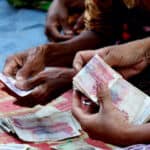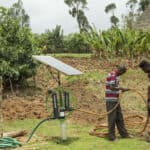Private Business Alone Can’t Bring Energy to the Last Mile: Why Philanthropy Should Shift its Focus to Scalable Non-Profit Models
Dotted across rural Uganda are countless former pay-as-you-go (PAYG) electricity shops, now overpainted with signs for other businesses that have moved in to take their place after non-dilutive grant funding dried up. They are a clear signal of the failure of Western-based market-led approaches to increase energy access in the last mile, both in Uganda and across the African continent.
But why did this occur? And what does this say about philanthropy and government’s focus on funding private businesses to solve stubbornly low energy access rates?
Back in 2017, I was perched atop a motorcycle holding a Sun King Pro 300 solar lamp. I was seated behind Juliet, founder of a community-based organization which delivers services in the local area, and which was working to establish a sustainable energy business. We were teetering on the edge of a rain-soaked mountain cliff in Bududa district on Mt. Elgon in eastern Uganda. Our destination was a Village Savings and Loan Association meeting, where 300 women were gathered as part of their peer-to-peer savings group, and where Juliet would explain how they could save money by bringing clean energy into their homes. It was one of many meetings I would go to as part of my efforts to found ENVenture, now New Energy Nexus Uganda, which supports community-based organizations such as Juliet’s in starting clean energy businesses.
These community-based organizations are already embedded in local communities across rural Uganda delivering many essential services. What our model does is provide them with loans, technical and business training to become entrepreneurs and distribute clean energy products: a truly grassroots and inclusive approach to solving the energy access challenge in last-mile communities.
As part of those efforts, ENVenture had conducted internal research, based on 25 household interviews in Bukibokolo — an isolated rural area in the Bududa district — which revealed that 95% of households there rely on firewood for cooking. With no access to solar distributors, residents resort to using kerosene for lighting up to four hours a day, or purchase AA batteries for handheld torches. They charge their mobile phones at local businesses. These issues make life more difficult in a community that is already grappling with both poverty and climate-related challenges, including catastrophic mudslides that impact their already under-resourced livelihoods.
These challenges are emblematic of the 760 million people without electricity and the 2.3 billion who lack modern cooking facilities — individuals who often live in the last-mile communities that are farthest from urban centers and least able to afford current clean energy solutions. The global community has made commendable progress toward the Sustainable Development Goal of universal energy access since the SDGs were established in 2015, when 1.3 billion people lacked access to electricity. Significant investment and support have gone into the off-grid clean energy sector, enabling many companies to emerge, developing solutions that range from pico solar lanterns to large-scale microgrids.
However, the focus has predominantly been on market-led interventions, such as PAYG solar, which allows customers to pay approximately US $0.25 to .50 a day for power, catering to populations on the periphery of the grid around major town centers. There is certainly a large market of underserved customers for PAYG technology. Yet my experience in Bukibokolo suggests that these market-led approaches are ill-suited for last-mile communities, and philanthropic efforts to subsidize PAYG solutions have largely failed to create sustainable businesses in these hardest-to-reach locations.
Last-Mile Populations Cannot Afford to Pay for Clean Energy
The crux of the issue lies in the fact that the last-mile population cannot afford clean energy at their current income levels. It is disingenuous to make the case that a person in Uganda who earns less than US $2 a day should be paying 25% of their daily income on energy and could afford to do so, when the average American spends about 3% of their income on energy, and even low-income households pay just over 8%.
This approach has not worked in most cases, and leading PAYG companies have mostly pivoted away from selling solar in these communities entirely. Yet in conference rooms across the Western world, experts in suits will still argue that there is a way to make money from the poorest people by selling them clean energy.
This is wishful thinking, as these businesses typically require support from philanthropic funders to even have a chance at establishing themselves. Yet according to ClimateWorks Foundation, only 6% of global climate foundation funding in 2022 was directed to climate change mitigation in Africa, which includes efforts to increase access to clean energy. That leaves limited funding for de-risking investment into renewable energy companies that are delivering energy access solutions. This, in turn, leaves the hardest-to-reach places behind.
The solutions to this problem are not groundbreaking innovations, but a proven and obvious approach: linking livelihood creation with energy sales. Successful interventions often come from non-profits and civil society groups focusing on this intersection, replicating what works rather than pursuing new and untested solutions. However, so many grant requests for proposals require applicants to be from the private sector only. The private sector absolutely needs access to non-dilutive funding to become viable, but the market doesn’t always know best — and global philanthropy should also include non-profit models that are already proven to reach millions with clean energy access.
Keys to Successful Non-Profit Energy Access Models
That’s the key conclusion I’ve arrived at after working on off-grid energy access in 12 countries in Africa and South Asia. Here are two other insights I’ve developed based on my observations of what works in these markets — an assessment that is also backed by 79,000 points of customer data from the new and excellent 60 Decibels report “Why Offgrid Energy Matters.”
1. Empowering women is essential: Women play a pivotal role as both consumers and purchasers of clean energy. They buy kerosene and charcoal to supply their energy needs, and can also be convinced to purchase a better alternative if it improves the health of their families and reduces the risk of fire. But women in excluded communities will often argue that the solution offered is too expensive to make the switch. By empowering these women and giving them the opportunity to earn income through selling clean energy products, energy access stakeholders can help make that switch a reality. Solar Sister, which uses this model in Africa, has reached over 4.3 million people with its clean energy products, creating income-generating opportunities for more than 10,000 women entrepreneurs. Pollinate Group has used a similar approach to bring solar and other products to 864,000 people in Nepal and India, creating income-generating opportunities for more than 2,200 women. Barefoot College, which also uses this model in India and globally, has reached over 2.4 million people with clean energy, creating income-generating activities for 3,500 women. These are just a few examples of non-profit organizations (not private sector companies!) that have scaled; their success suggests that philanthropy could be better targeted towards replicating proven ecosystem-building models working to uplift women, even if those models are implemented by non-profits.
2. Empowering communities is equally essential: Solutions that anchor communities, especially through community leaders, are more likely to succeed. This is the clear lesson from SELCO Foundation, a pioneer in building an ecosystem around the beneficiaries of decentralized and sustainable energy solutions. SELCO Foundation has created income-generating opportunities for 900,000 people and exclusively focuses on energy for development, such as energy for health services. Additionally, New Energy Nexus Uganda, which has trained about 200 community-based organizations as its beneficiaries, has reached over 127,000 low-income people in rural Uganda with clean energy and has created income-generating opportunities for over 1,000 people, 70% of whom are women. There are so many examples of non-profit models that have scaled to serve the last mile. Imagine if each of these organizations received $1 million in unrestricted catalytic funding: How many more thousands of the underserved could be reached — while delivering greater dollar-to-impact bang for the buck?
Four years later and despite her best efforts and entrepreneurial drive to create a profitable clean energy business, Juliet’s business margins were too low — due to high operating costs, debt and COVID-19 — for her community-based organization to maintain a sustainable business. Perhaps donor focus should not solely be on creating private businesses, but enabling wrap-around services that empower women and communities to increase their income and allow for the uptake of clean energy solutions — without imposing unsustainable financial burdens. By scaling successful non-profit models, offering them the right support on their entrepreneurship journey, and linking livelihoods to energy sales, we can truly bridge the clean energy gap for the hardest-to-reach populations.
Aneri Pradhan is COO at New Energy Nexus.
Photo: Copyright New Energy Nexus/Sandra Ruong’o



